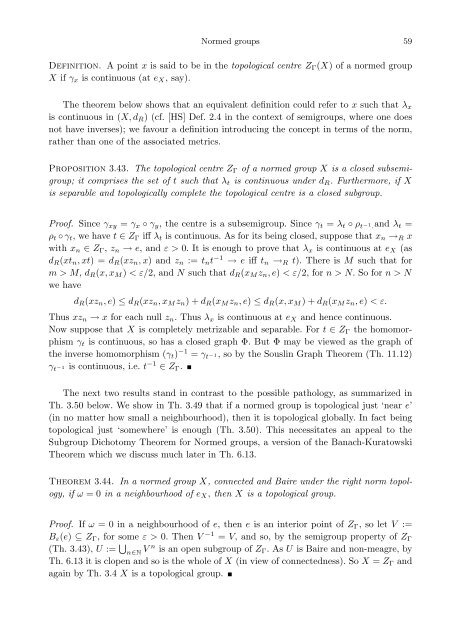Normed versus topological groups: Dichotomy and duality
Normed versus topological groups: Dichotomy and duality
Normed versus topological groups: Dichotomy and duality
You also want an ePaper? Increase the reach of your titles
YUMPU automatically turns print PDFs into web optimized ePapers that Google loves.
<strong>Normed</strong> <strong>groups</strong> 59Definition. A point x is said to be in the <strong>topological</strong> centre Z Γ (X) of a normed groupX if γ x is continuous (at e X , say).The theorem below shows that an equivalent definition could refer to x such that λ xis continuous in (X, d R ) (cf. [HS] Def. 2.4 in the context of semi<strong>groups</strong>, where one doesnot have inverses); we favour a definition introducing the concept in terms of the norm,rather than one of the associated metrics.Proposition 3.43. The <strong>topological</strong> centre Z Γ of a normed group X is a closed subsemigroup;it comprises the set of t such that λ t is continuous under d R . Furthermore, if Xis separable <strong>and</strong> <strong>topological</strong>ly complete the <strong>topological</strong> centre is a closed subgroup.Proof. Since γ xy = γ x ◦ γ y , the centre is a subsemigroup. Since γ t = λ t ◦ ρ t −1 .<strong>and</strong> λ t =ρ t ◦ γ t , we have t ∈ Z Γ iff λ t is continuous. As for its being closed, suppose that x n → R xwith x n ∈ Z Γ , z n → e, <strong>and</strong> ε > 0. It is enough to prove that λ x is continuous at e X (asd R (xt n , xt) = d R (xz n , x) <strong>and</strong> z n := t n t −1 → e iff t n → R t). There is M such that form > M, d R (x, x M ) < ε/2, <strong>and</strong> N such that d R (x M z n , e) < ε/2, for n > N. So for n > Nwe haved R (xz n , e) ≤ d R (xz n , x M z n ) + d R (x M z n , e) ≤ d R (x, x M ) + d R (x M z n , e) < ε.Thus xz n → x for each null z n . Thus λ x is continuous at e X <strong>and</strong> hence continuous.Now suppose that X is completely metrizable <strong>and</strong> separable. For t ∈ Z Γ the homomorphismγ t is continuous, so has a closed graph Φ. But Φ may be viewed as the graph ofthe inverse homomorphism (γ t ) −1 = γ t −1, so by the Souslin Graph Theorem (Th. 11.12)γ t −1 is continuous, i.e. t −1 ∈ Z Γ .The next two results st<strong>and</strong> in contrast to the possible pathology, as summarized inTh. 3.50 below. We show in Th. 3.49 that if a normed group is <strong>topological</strong> just ‘near e’(in no matter how small a neighbourhood), then it is <strong>topological</strong> globally. In fact being<strong>topological</strong> just ‘somewhere’ is enough (Th. 3.50). This necessitates an appeal to theSubgroup <strong>Dichotomy</strong> Theorem for <strong>Normed</strong> <strong>groups</strong>, a version of the Banach-KuratowskiTheorem which we discuss much later in Th. 6.13.Theorem 3.44. In a normed group X, connected <strong>and</strong> Baire under the right norm topology,if ω = 0 in a neighbourhood of e X , then X is a <strong>topological</strong> group.Proof. If ω = 0 in a neighbourhood of e, then e is an interior point of Z Γ , so let V :=B ε (e) ⊆ Z Γ , for some ε > 0. Then V −1 = V, <strong>and</strong> so, by the semigroup property of Z Γ(Th. 3.43), U := ⋃ n∈N V n is an open subgroup of Z Γ . As U is Baire <strong>and</strong> non-meagre, byTh. 6.13 it is clopen <strong>and</strong> so is the whole of X (in view of connectedness). So X = Z Γ <strong>and</strong>again by Th. 3.4 X is a <strong>topological</strong> group.
















